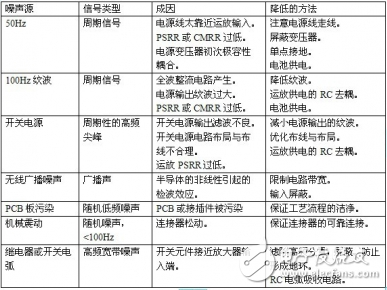The noise can be random or repetitive, internally or externally generated, in the form of voltage or current, narrowband or wideband, high or low frequency. Noise typically includes the inherent noise of the device and external noise. Intrinsic noise includes: thermal noise, shotgun noise, and low frequency noise (1/f noise), which we will not discuss here. External noise usually refers to power supply noise, spatial coupling interference, etc., and usually can be avoided or reduced by reasonable design. Reducing the effects of external noise is critical to the performance of low-noise op amps.
Common external noise sources

Power ripple
In a full-wave rectified linear regulated power supply circuit, 100 Hz ripple is the dominant power supply noise. For op amp circuits, the 100 Hz noise level is typically controlled within 10 nV-100 nV (RTI), depending on three factors: The power supply rejection ratio (PSRR) at 100 Hz, the ripple rejection ratio of the regulator, and the input filter capacitor of the regulator. Figure 1 shows the PSRR-frequency curve of the OP77. It can be seen that the OPNR has a PSRR of about 76 dB at 100 Hz. To achieve a performance of no more than 100 nV (RTI), the ripple of the power supply must be less than 0.6 mV. Commonly used three-terminal regulators typically provide approximately 60dB of ripple rejection. In this case, the regulator's input filter capacitor must be large enough to limit the ripple at the input to below 0.6V.

Power supply decoupling
A typical series regulator supplies a power supply with an amplitude of 150uV and a frequency range of 100Hz-100KHz. The switching power supply is more serious. The PSRR of the op amp is reduced by 20dB/Decade at high frequencies. The foot plus RC or LC decoupling network can filter most of the noise, the circuit form is shown in Figure 3. When using RC decoupling, it should be noted that changes in load current can cause modulation of the voltage on the power supply pin.

Figure 3: RC decoupling for op amp supply
Power adjustment rate
Any change in supply voltage will cause a change in the input bias current of the op amp. The PSRR of OP77 in Figure 1 is 126dB (0.5uV/V) at DC. The change in supply voltage is a potential source of low frequency noise. In low-noise op amp applications, it is important to reduce the ripple of the power supply and increase the regulation of the power supply. Insufficient power regulation often causes annoying low-frequency noise.
For industrial control environment wired communication equipment and wireless communication equipment. Wired communication equipment mainly introduces serial equipment communication for industrial field, professional bus-type communication, industrial Ethernet communication and conversion equipment between various communication protocols, including routers, switches, modems and other equipment. Wireless communication equipment mainly includes wireless AP, wireless bridge, wireless network card, wireless lightning arrester, antenna and other equipment. Communications also include military communications and civilian communications
Communication Pcb,Wireless Communication Pcb,Optical Communication Circuit Board,Printed Communication Circuit Boards
Chuangying Electronics Co.,Ltd , https://www.cwpcb.com
